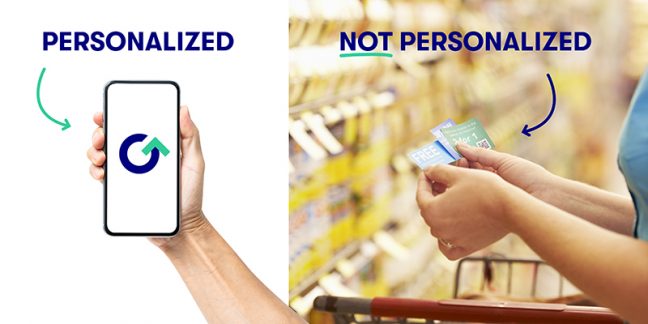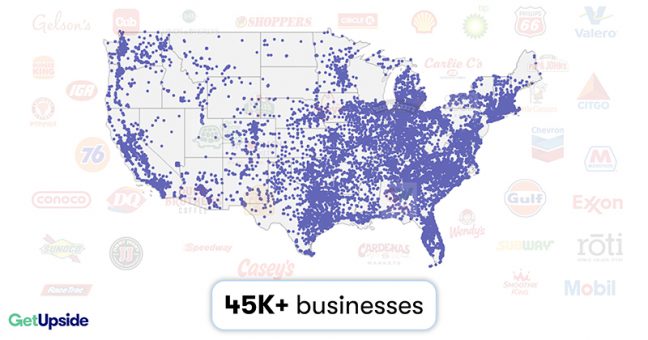by Eric Pereira / content creator
GetUpside is a Washington D.C.-based retail technology company that uses personalized cashback promotions to bring shoppers more value and proven profit to brick-and-mortar businesses. Tyler Renaghan, VP of grocery at GetUpside, recently discussed the most cost-effective ways retailers can acquire new customers in this email interview with The Griffin Report.
Can you talk more about the downward pressure retailers are facing on their net operating margin?
Right now, retailers are facing tremendous downward pressure on net operating margin thanks to continued supply chain issues, higher labor costs, strained customer spending because of inflation and revenue paid to third-party delivery services. So while sales continue to surge, profits are not always following suit.
With so much out of their control, it’s hard for retailers to imagine how they could achieve something like a 1 percent sales lift without giving away the field (sacrificing profit). The good news is that cost-effective technological innovation is helping them get there; and GetUpside is a great example. These tools require retailers to think differently about their business and move away from traditional programming that cannibalizes their own profit.
What are the most cost-effective ways grocers can acquire new customers? How can GetUpside make this possible?
A “successful” acquisition strategy is one that consistently pays back customer acquisition costs so retailers earn new profit.
Today, we estimate that the majority of retailers actually lose money on programming like coupons, out-of-home advertising and in-house loyalty programs. That’s because top-line metrics like clicks, sign-ups or transaction volume growth fail to capture the full bottom-line picture – specifically, the up-front investment in acquiring those customers and whether their behavior changes enough to pay back the initial investment to acquire them.
Every promotion through GetUpside is personalized for each shopper. Our back-end tech serves them with the minimum possible, margin-bound offer that motivates each of them to change their buying behavior. That way, retailers can provide the most compelling customer promotions possible (two to three times more than with any other app) while maximizing their net profit. It’s a win-win.

How does GetUpside enable retailers to think differently? What are some examples of traditional programming that cannibalize profit?
Right now, sophisticated retailers create customer segments and predict what type of incentive will motivate them to buy more, send out campaigns and then measure how they performed afterward with limited data.
The most competitive retailers are realizing two important things:
▶ Blanket promotions waste money. There are many rewards and loyalty programs out there that group customers based on their overall spend and treat the customers in each group the same way; as if they all have the same needs or are motivated by the same things.
But in reality, we know that each of our needs are unique. So retailers end up providing unnecessary discounts to customers who would have paid full price and provide sub-optimal discounts to the customers that actually need more incentive to get them to choose a retailer for the first time. That’s bad for business and leads to a deficient customer experience.
▶ Loyalty programs are good for customer retention, not necessarily acquisition. Loyalty programs retain customers with strong brand affinity so they are not swayed by nearby competitors. The nation’s top-performing retailers are using loyalty programs as effectively as possible, getting about 30 percent of their existing customers to sign up and about 10-15 percent of those customers to remain loyal.
Unfortunately, there is no clear indication that the programs themselves are making customers behave differently, since customers that choose to join loyalty programs are naturally more inclined to buy more from that grocer (also known as selection bias). Not to mention that those programs are not reaching new customers, or the 70 percent of existing customers who choose not to participate.
We work with nearly 400 grocers – and 45,000 businesses overall – that have shifted their mindset, and use GetUpside to personalize every single shopper’s promotion on a one-on-one basis to actually move the needle on their spend. They also get in touch with the millions of customers in their area who have transacted with a competitor and profitably switch those purchases to their store.

How? More than 30 million customers use GetUpside to decide where to buy their groceries. That number grows every day as big banks and other top apps such as Uber, GasBuddy, DoorDash and Instacart push GetUpside offers to their cardholders and drivers.
Because these new customers are online, GetUpside knows where and when they are in their cars running errands. The platform provides dynamic, margin-bound promotions to incentivize a customer to change their behavior and reroutes those customers right to your store. So you reach new customers that would not have chosen your store otherwise.
All of this is not to say that grocers should cancel their investment in loyalty programs. Instead, they should layer on additional tools. When customers use GetUpside alongside your loyalty program or proprietary app, those loyalty customers visit more than usual.
Making both programs available to customers maximizes the investment most retailers have made in their loyalty program, since GetUpside keeps promotions within available margin to guarantee profit. Some retailers even integrate GetUpside into their own app so they can simplify their customers’ experiences.
How fast can retailers begin to see results after using GetUpside?
In just a few months, GetUpside is profitably driving a 1 percent sales lift to our most engaged retailer partners. In the first few months across all of our nearly 400 retailers, on average they see: 10 percent lift in basket size; 2.5 times more visits from customers; and 2.8 times more spend from customers
GetUpside is cost-effective for every retailer, big or small. You can begin with GetUpside in as little as two weeks, and there is absolutely no work required for the retailer. None. No IT integration or upgrades, staff training or in-store signage. We just need approval to access the anonymized transaction data retailers pay for and GetUpside does the rest.
Again, GetUpside does not have to replace a retailer’s existing programming. We know that in the face of COVID-19 most retailers have invested in new loyalty programs and e-commerce offerings. Instead, GetUpside boosts the impact of existing programs by bringing in new customers, because those programs are limited to the customers the retailers already serve.
Are there any 2022 goals you’d like to highlight for GetUpside?
GetUpside has big plans for 2022. Beyond signing partnerships with another 1,000 or more grocers, our product will only continue to improve and drive more visits, bigger baskets and more profit to our partners.
We’ll move forward with more Check In rollouts (like we did with Schnucks), begin to provide item-level promotions and introduce customers to a retailer’s entire offering (like the center-store).
Beyond 2022, imagine a world where GetUpside’s machine learning platform dynamically identifies the right types of experiences and incentives at the precise time every individual customer needs them, through a retailer’s owned communication channels like their app, website, loyalty program and email.
In practice that looks like knowing in real time that Joe needs bananas and directing him to the produce that will expire if not purchased today. Or knowing that Betsy is a regular customer and surprising her with express checkout at a line that’s empty. That would considerably maximize loyalty and retention of a customer and would be a true differentiator in today’s market of fierce pricing battles.
There is a lot in the works, so the earlier retailers get involved, the better for their business.
For more information, visit app.getupside.com.
To read more original content from The Shelby Report, click here.

